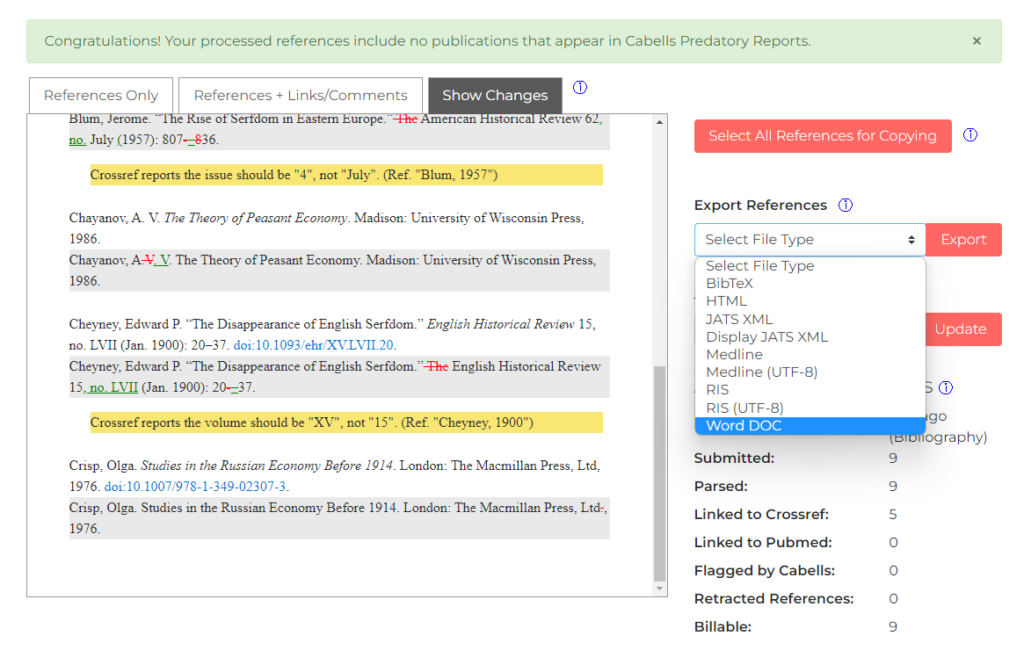One of the more tedious aspects of preparing a manuscript for publication is checking citations and reference lists. As citation organization tools have gained traction for the research process, machine learning has started to offer the possibility of relieving some of the task of re-checking references on the back end. A previous post explored one such tool for checking the internal consistency of in-text citations and bibliographies. Unfortunately, for now, the technology remains limited to APA and Harvard.
For authors who work primarily with Chicago formatting, there remains as yet no reliable tool to check in-text citations against a bibliography. When it comes to reference lists, however, Edifix may offer a potential supplement for writers looking to cut down the time spent combing through their entire set of references. How effective is Edifix for reference checking?
How does it work?
Edifix draws on cloud-based databases (PubMed and Crossref) to check and correct references. Users can copy and paste references into a simple window, select the governing style guide, and let the application run. The results are reported under three different tabs, where writers can see the cleaned references, the cleaned references plus comments, or all of the changes suggested by Edifix. Specific concerns regarding a reference’s origin are flagged in yellow for further investigation. References may also appear in light gray font, which indicates that the tool failed to parse the citation. This usually occurs due to the presence of an unusual source, the citation of which is less than completely standardized. References from older books and journals, unpublished dissertations, or certain types of media may thus test the limitations of the software.

Pros
One of the main benefits of the Edifix program is certainly the clean interface. With relatively few buttons to worry about, the tool is easy to navigate and quickly learn. Edifix also supports a wide variety of style guides, which allows authors to convert their references easily from one format to another, if necessary (e.g., from APA to Chicago). The clean references can then be exported into a number of programs (BibTeX, Word, HTML, etc.), or simply copied and pasted. The technology will also flag retracted publications and add or fix DOI links. Most importantly, the process runs quickly and efficiently–which is absolutely necessary for these kinds of tools.

More broadly, authors will save time checking individual references. For those who rely on Zotero, Evernote, or another citation gathering tool, Edifix catches any information that may be missing from the organizational software. With references checked, authors and editors can be confident that they are checking in-text citations against an accurate bibliographical list.
Cons
The major drawback to Edifix is that it does not cross-check references for internal consistency with in-text citations. Edifix offsets the time spent checking bibliography entries, but writers still must check in-text references manually. Depending on the extensiveness of the bibliography in question, this may only save marginal time. For writers of longer monographs, it seems likely to save more time by pre-checking the bibliography before the writer or editor must do any manual checking.
At the same time, the subscription is fairly expensive. The basic subscription begins at $40 per month for 250 references, and the tiers scale up from there. For individual authors, this may be too steep, or it may make Edifix a useful one-off tool rather than a regular fixture. On the other hand, Edifix does offer a fairly generous free trial period, providing 100 reference checks over the period of one month. Interested writers should thus be able to evaluate the tool thoroughly to see if it is one they would like to use. In addition, Edifix offers subscription plans at the institutional level, so scholars attached to universities or other research institutions may find it worthwhile to inquire about one of these subscriptions.
The final potential drawback features the substantial amount of gray text in the second image in this article. While Edifix added accurate DOI links for all of the references (which allow for manual checking), all of the citations that failed to parse during this test were pre-1975. This problem also seemed to crop up more when dealing with a Chicago-formatted bibliography than with, say, APA. This is likely due to the structure and orientation of the cross-checking databases currently used. Hopefully, as the technology improves, the utility for authors working with older secondary sources will also improve.
Final Thoughts
Edifix offers an intriguing potential tool for writers looking for ways to save time when it comes to reference checking. For longer manuscripts in particular, it may provide a fairly cost effective way to save substantial amounts of time. The clean interface and efficient processing make it an attractive tool for busy authors.
It does not, however, entirely solve the problem for writers working with the Chicago Manual of Style. Particularly for authors working with older sets of sources, the savings may only be marginal. Authors of shorter articles and monographs may also find the savings in time and effort only marginal. Nevertheless, given the generous reference allowance during the free trial period, I would recommend that authors explore Edifix to see if it fits their needs.